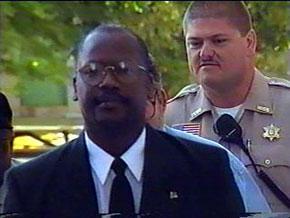 Paul Alexander’s concise article in the Daily Beast provides the best summary of this complicated case published to date. If you want to know more about DA Doug Evan’s ties to an unapologetically racist organization, or the reasons many (myself included) find the witnesses in this case less than credible, you can read Alexander’s eBook Mistried or check out my blogging on the subject. But if you have never heard of Curtis Flowers and are wondering why Alexander calls him “Mississippi’s Marked Man” this is a great place to start. Bottom line, this case has never been investigated, and that needs to change. AGB
Paul Alexander’s concise article in the Daily Beast provides the best summary of this complicated case published to date. If you want to know more about DA Doug Evan’s ties to an unapologetically racist organization, or the reasons many (myself included) find the witnesses in this case less than credible, you can read Alexander’s eBook Mistried or check out my blogging on the subject. But if you have never heard of Curtis Flowers and are wondering why Alexander calls him “Mississippi’s Marked Man” this is a great place to start. Bottom line, this case has never been investigated, and that needs to change. AGB
Curtis Flowers: Mississippi’s Marked Man
by Paul Alexander Jun 29, 2013 4:45 AM EDT
In a shocking case of injustice, an African-American has been tried for the same murder six times, pursued by a crusading prosecutor. Paul Alexander on Mississippi’s marked man
As the Trayvon Martin killing in Florida continues to grab national headlines, a case, now playing out in Mississippi, also raises questions about race and justice in America.

Curtis Giovanni Flowers, left, listens to testimony in his third capital murder trial in Winona, Miss. Feb. 6, 2004. (Dale Gerstenslager/Winona Times via AP)
To be sure, in this year commemorating the 50th anniversary of the Children’s Crusade in Birmingham, President Kennedy’s civil-rights speech, and the March on Washington, it is appropriate to note the strides that have been made to overcome past racial injustice. Today, of the 435 members of the House of Representatives, 41 are African-American. Well over 600 cities have black mayors. And the country has elected (and reelected) its first African-American president.
But despite these advances, injustices remain. For years, the nation’s prison population has contained a disproportionately large number of African-American prisoners. A good percentage of these inmates are incarcerated on minor infractions, such as possession of small quantities of drugs. Worse, some are there under questionable circumstances. Few cases are more dubious than that of Curtis Flowers, a black man who has spent the last 16 years on death row in Mississippi for a crime to which he was connected by the most meager of circumstantial evidence.
Of course, Mississippi has a long history of racial incidents, from the Duck Hill lynchings in 1937 to the Mississippi Burning murders of three civil-rights workers in Philadelphia, Mississippi, and the assassination of Medgar Evers in Jackson in the 1960s. Another small town, Winona, achieved notoriety when voting-rights activist Fannie Lou Hammer spoke at the 1964 Democratic National Convention and described how, while under arrest in Winona, she was savagely beaten by police. With Winona as backdrop, it should not be surprising, then, that Curtis Flowers’s saga has racial overtones.
It was a horrendous crime. On the morning of July 16, 1996, Bertha Tardy, 59, a local merchant in Winona, and three of her employees were gunned down execution-style in her place of business, Tardy Furniture. Each victim was shot in the head. Tardy and two employees died instantly. The third died in the hospital.
The horrific quadruple homicide shocked the sleepy Southern town. Prosecutor Doug Evans felt intense pressure to find who committed the crime. On the day of the murders, without considering any other suspects, he settled on a 26-year-old black man named Curtis Flowers, a common laborer and part-time gospel singer with no criminal record.
Two weeks earlier, Flowers had worked for Tardy for three days but quit after he damaged three golf-cart batteries he was transporting for Tardy’s husband. Flowers’s unclaimed payroll check lay on Tardy’s desk on the day she died. In addition, on the morning of the murders, a .38-caliber handgun was stolen from a car belonging to one of Flowers’s relatives — the same type of handgun used to commit the murders (although it was later established that bullets fired from the gun did not match those found at the crime scene.) Finally, a bloody footprint near one of the victims was made by a Grant Hill Fila-brand sneaker, size 10-and-a-half. An empty shoebox for the same size and make of shoes—but not the sneakers themselves—was found in the duplex Flowers shared with his girlfriend, who told police the shoes, long since worn out and discarded, belonged to her teenage son, not Flowers.

Forensic expert Melissa Schoene, right, describes the crime scene to the jury in Curtis Giovanni Flowers murder trial, Friday, Feb. 6, 2004. (Dale Gerstenslager/Winona Times via AP)
A defendant can be tried, Evans told local reporters after the sixth trial, “as many times as it takes.”
No murder weapon was found. Flowers’s fingerprints did not appear at the crime scene, on the shoebox, or on his relative’s car. When he was first interviewed by police, Flowers was wearing Nike sneakers, not Filas. Upon interrogation, Flowers had no blood splatters on his clothes. He passed a lie-detector test. Still, based on scant circumstantial evidence (a check, a relative’s stolen gun, and an empty shoebox), plus profoundly conflicted eyewitness accounts that some observers of the case claim were fabricated, Flowers was arrested and charged with four counts of capital murder. He said he was in his duplex at the time of the murders, but since he was there alone he had no alibi.
What has followed is Doug Evans’s relentless, Javert-like prosecution of Flowers. It has now consisted of six trials, making Flowers one of a handful of people in American history to be prosecuted six times for the same murder charges. The first two trials, both resulting in conviction, were overturned on appeal by the Mississippi Supreme Court, citing prosecutorial misconduct. A third trial ended in a conviction that was reversed by the higher court, now because “the state engaged in racially discriminatory practices during the jury selection process.” Evans had used similar tactics in the first two trials to ensure that those juries were predominantly white as well.
For the next two trials, Evans seated racially balanced juries reflective of Winona’s population. Both trials ended in mistrials, with all of the white jurors voting to convict and all of the black jurors voting to acquit. Indeed, Evans had consistently played up the case’s racial undercurrent, one that harked back to ghosts of the past: an angry young black man, compelled by what he perceived to be an affront—loss of employment and money—got his revenge by massacring his former (white) employer as well as three of her employees.
For the sixth trial, Evans returned to a predominantly white jury. The result was another conviction, this one handed down, on June 18, 2010, in less than half an hour. What should happen if the latest conviction is overturned on appeal, which could be handed down any day now? A defendant can be tried, Evans told local reporters after the sixth trial, “as many times as it takes.”
What is noteworthy, as the media again focuses on the Trayvon Martin killing, is how little national attention has been paid to the Flowers case, which is taking place within driving distance of where Oprah Winfrey was born and Morgan Freeman lives. Meanwhile, Curtis Flowers remains on death row, waiting.
Paul Alexander is the author of Mistried, about the legal ordeal of Curtis Flowers, just published by Rosetta Books. He is the author of eight books, including biographies of Sylvia Plath and J.D. Salinger and political chronicles of John Kerry and Karl Rove, and three bestselling Kindle Singles. His numerous articles have appeared in publications ranging from The New York Times to Rolling Stone to The Daily Beast.
For inquiries, please contact The Daily Beast at [email protected].
